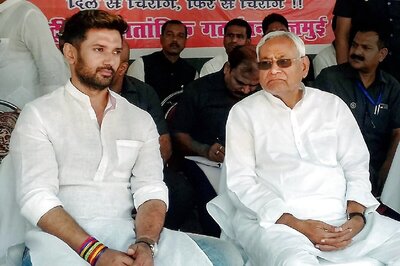
views
Kolkata: The faded hammer-and-sickle signs hand-drawn on the weather-worn walls of 9, Dilkusha Street in Kolkata are hard to spot from a distance. More easily visible are several pale green windows adorning the red-and-beige building, facing a nest of wires outside, and a sign in bold red next to a white gate that reads ‘Suresh Kutir’ in Bengali. But what you certainly wouldn’t know by looking at the largely nondescript structure is the list of illustrious people who were regular visitors or residents of this ‘commune’ over the years: Jyoti Basu, EMS Namboodiripad, Makineni Basavapunnaiah, Bhalchandra Trimbak Ranadive, Promode Dasgupta, and other big names from the country’s communist pantheon.
Despite having held power in West Bengal for seven consecutive terms, from 1977 to 2011, today’s Left Front is hardly a force worthy of notice in the state and is fighting to stay relevant in India. The constituent parties have been reduced to single digits in Parliament, and have lost all their traditional bastions except Kerala and a few university campuses.
Once steered by strong leaders like Jyoti Basu, Anil Biswas, Promode Dasgupta and Buddhadeb Bhattacharjee – all the Left parties are now struggling to hold onto any political space in the state.
The crisis is so alarming that it has forced the communist parties to join hands with the Congress to stay afloat in Bengal. However, that doesn’t seem to be working either. In the results of bypolls for three assembly seats announced on Thursday, the Left-Congress combine finished third everywhere, with the ruling Trinamool Congress (TMC) emerging victors and the Bharatiya Janata Party (BJP) runners-up.
Despite the near-absolute rout of the Communist Party of India (Marxist)-led Left Front in the previous Lok Sabha elections and Mamata Banerjee’s ascent to power in the 2011 Bengal assembly polls, the contributions of people who lived in communes and embraced the Left ideology for decades remain relevant, say supporters.
They were the comrades who lived in the ‘Calcutta communes’ (rooms hired by the party in the 1960s to house a few) who gave up everything, including family, for the party till their last breath.
One such popular commune is Suresh Kutir near Kolkata’s Park Circus area.
Spread over nearly 1,400 square feet, the building may not be bustling with activity today (most of the inhabitants have passed away over the years), but the communist stalwarts who lived here left indelible marks of their ideology and struggle.
One has to pass through a half-wooden door with an improvised hasp to get in to the commune which has over the years housed legendary communists like Muzaffar Ahmad, Hashi Dutta, Kamal Sarkar, Samar Mukherjee, Abdullah Rasool, Nirod Chakraborty and Mahadeb Saha since 1967, while others like Basu, Namboodiripad and Ranadive were frequent visitors.
Inside the building, several invaluable records, books, citations and posters lie in open racks, gathering dust.
“This is the room where former CPI(M) MP and MLA Samar Mukherjee used to live till he died in 2013. Presently, no one stays here as all of them have passed away. I live here as caretaker on the first floor,” says Keshav Pahari, a CPI(M) member.
Before the TMC came to power, journalists who covered Left politics for years kept making the rounds of Suresh Kutir. But, nowadays, most people walk past it without a second glance.
“Only a few senior journalists have an idea about the significance of the building. Except party leaders, no one comes here anymore. I am lucky that I got an opportunity to spend time with several party stalwarts in this commune. Almost all the legendary leaders either stayed or visited,” recounts the caretaker.
Pahari says he was close to Samar Mukherjee who left his family in the 1940s to live in a commune in Howrah district. Later, he shifted to the Dilkusha building in 1967. “The commune was set up in 1967 to house Comrade Muzaffar Ahmed. Samarda moved here, leaving a comfortable family life, to give him company,” he says.
Pahari recalls how most of the inhabitants used to split their lunch with drivers, servants and visitors to save party funds.
“Once Kamal Sarkar became annoyed with Hashi Dutta. This happened when Abdullah Rasool passed away and Hashida took charge of monthly expenses of this commune. He went for cost-cutting and Kamalda didn’t like it. One day he became angry when he saw cabbage curry for lunch. He asked, ‘Why cabbage curry and why not fish?’ Hashida politely replied, ‘It’s good for health and, with this and steamed rice, we don’t need anything else’,” Pahari recounts.
Similarly, when Biman Bose, CPI (M) politburo member and chairman of the West Bengal Left Front Committee, joined the party, he too left his south Kolkata house to stay at a party commune, 171/2B AJC Bose Road, at the age of 18. Later he left that commune and now stays in a small room in the party office at 31, Muzaffar Ahmed Bhawan on Alimuddin Street.
CPI (M) leader and author Kapil Thakur said, “Those leaders who lived in communes cannot be compared with anyone else. Today, it is difficult to find such dedication.”
There are several communes in the state where Left leaders still stay while working for their parties. One such facility is located in Rabindra Nagar in Paschim Medinipur (or West Midnapore) where CPI state secretariat member Santosh Rana lives.
“Yes, I live in a commune and I think that is the best place from where one can work full-time for the party,” he told News18. “I don’t believe that there is no existence of Left Front today. It will be wrong to believe that everyone has become corrupt. I feel that the new generation has a lot of power and energy to revive the party. They need to show the right direction.”
Santosh Rana stays in the West Midnapore commune with other CPI leaders Ashok Sen (CPI district secretary), Prabhat Patra (assistant secretary) and Biplab Bhatta.
Bhatta says, “For the last 20 years, I am working with the CPI and as a trade union whole-timer. I am thankful that I am living in a commune and serve my party honestly. It is unfortunate that despite giving all for the party, we are struggling for existence. In think this is a temporary crisis and we will overcome it one day.”
State general secretary of another communist outfit, the Socialist Unity Centre of India (SUCI), Prabhas Ghosh, 85, too stays in a commune at Shibpur in Howrah. “We call it a Centre, which is the advanced stage of a commune,” he says.
Ghosh and 30 others live in the three-storeyed building – 27, LNT Road in Shibpur – which is the biggest SUCI commune in Bengal.
When asked why the Left Front is struggling for relevance in the country, he said, “When we started our political journey, the impact of the Left was very high in India, especially in Bengal. Over the years, it has gone. I call it ideological bankruptcy. More than utilising Marxism and Leninism, leaders were attracted towards power.”
SUCI has other Centres, including at Salt Lake and Shyambazar in Kolkata, where a lot of activities and discussion sessions are organised by the inhabitants.
Many residents of the communes feel that a day will come when this culture will become history in Bengal as most young workers have their own way of moving forward with the party’s ideology, which is unlikely to match the paths followed by comrades of the early 1960s to 80s.




















Comments
0 comment